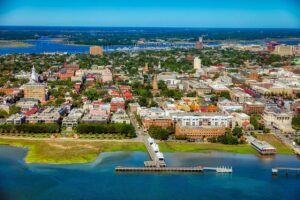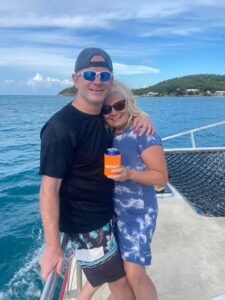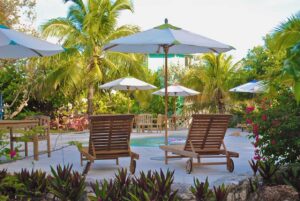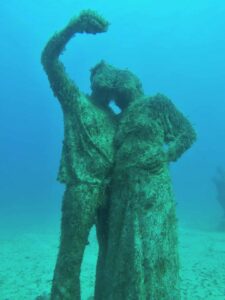The Florida Keys are aptly named, because they do offer the “keys” to a boating paradise unmatched anywhere in our lower 48 states. If you mention those two magic words — the Keys — to any boater in Florida, immediately what springs to mind are visions of sparkling clear waters, snorkeling, scuba diving, tickling for lobsters, deep-sea fishing, back-bay flats fishing, and simply relaxing and letting go.
A coral rock archipelago and accompanying barrier reef that stretch 200 nautical miles from Key Biscayne to the Dry Tortugas comprise this national marine sanctuary. And fortunately for boaters, the Keys are easy to transit in all weather, day or night, because the naturally formed Hawk Channel is well marked for buoy hopping and offers comfortable passage when the seas are raging outside the reef in the Gulf Stream.
We’ll begin our cruise from the Miami area and head south, keeping the prevailing easterly winds first on our beam and then on our stern as the Keys turn westward.
LEG 1 – Key Largo
Key Largo offers a relaxed atmosphere during the winter boating season — and, obviously, shares a name with a classic 1948 Humphrey Bogart and Lauren Bacall movie. Strangely enough, there is another Humphrey Bogart connection to Key Largo: The original African Queen, the steam-powered star of the Bogart and Hepburn movie of that same name, has been restored to its original Hollywood splendor and now gives tours around Key Largo. She departs five times daily from Marina Del Mar located at Mile Marker 100 along Highway 1. (By land, locations in the Keys are noted by their mileage from Key West, which is Mile Marker/MM 0). You can pretend to be Mr. Allnut while cruising the Key’s canals.
But the real star of Key Largo is John Pennekamp Coral Reef State Park. The upland park on Largo Sound offers kayaking and canoeing through mangrove swamps and tropical hammocks, and snorkeling and diving at its marine park out on the reef. Pick up a mooring ball at Molasses Reef or the perennial favorite Dry Rocks Reef and put on your mask, snorkel and fins. Dry Rocks is home to the foot bronze Christ of the Deep statue, which sits below the surface.
Dock your boat overnight at the Ocean Reef Club and experience the megayacht lifestyle. The marina offers just about every amenity you can imagine: golf course, spa, tennis courts, watersports, and even a cooking school for kids.
LEG 2 – Islamorada
Quick: What does Islamorada mean in Spanish? Time’s up! “Purple island” is the answer. Why the early Spanish explorers named this cayo purple has been lost to history. Today, Islamorada is also known as the Village of Islands and actually encompasses five isles, from Plantation Key in the north to Lower Matecumbe Key in the south. Islamorada is also the Sportfishing Capital of the World and was made famous by President George H.W. Bush, then a frequent visitor and avid fisherman. Whether your angling leans toward bonefish, tarpon or sailfish, you can have it all here. However, if your interest in sea life is more up close and personal, visit Theater of the Sea to swim and interact with dolphins, sea lions, sharks and stingrays.
As you head down Hawk Channel looking for a marina to berth your yacht, you’ll pass Hens & Chickens, a well-marked group of shoals off Plantation Key. Turn up Snake Creek to the Florida Bay side of the Keys to find Plantation Yacht Harbor at MM 87. The marina is well protected from the weather and located within a municipal park that has a swimming pool and tennis courts. It is an excellent base from which to start your exploration of the local restaurants and galleries. On the ocean side, the Postcard Inn Beach Resort & Marina (formerly Holiday Isle at MM 84) has been undergoing extensive renovations and improvements. The marina offers dockage for vessels up to 100 feet, and, thankfully, you can still enjoy a cocktail at the muchloved Holiday Isle tiki bar.
LEG 3 – Duck Key
Next stop is Duck Key — or, more specifically these days, Hawks Cay Resort & Marina at Duck Key. The entrance channel is not for the faint-of-heart mariner when the wind and seas are up and they happen to be on your stern. As you surf down the waves, be prepared to make a sharp 90-degree turn to starboard into a quiet canal that leads to the marina.
Hawks Cay is a family-friendly resort with lots of activities geared toward kids and teens. There are five swimming pools, plus outings such as nature hikes and scavenger hunts to keep everyone from getting bored. Swim with Atlantic bottlenose dolphins at the resort’s Dolphin Connection center, or while the kids are being kept busy, relax at the Calm Waters spa with a signature Key lime-mojito body treatment. For a real mojito that goes down the hatch, have the bartender at on-property Alma’s muddle one for you at the end of the day.
LEG 4 – Marathon
Marathon, on Vaca Key, is the most developed city between Key West and Key Largo and is the gateway to the Seven Mile Bridge on the Overseas Highway. Marathon is also a boating center with a number of marinas, a mooring field and a boatyard. Access to a large West Marine store, two supermarkets and even a Home Depot make Marathon a great stopover for repairs and reprovisioning. The Marathon Marina, Boatyard & RV Resort, located in Boot Key Channel between green markers 7 and 9, can handle vessels up to 125 feet and has a beautiful new pool, an oceanfront restaurant and bar and maintenance facilities that include a 75-ton travel lift.
Marathon also has many other dining options, from ultracasual Keys Fisheries, where you can still watch the fishermen come in with their stone-crab catch (stone crab season runs from Oct. 15-May 15), to the elegant Butterfly Café at Tranquility Bay Resort.
LEG 5 – Little Palm Island
Did you ever see the movie “PT109,” the heroic biopic about a young John F. Kennedy? That was filmed on what is now Little Palm Island Resort & Spa. Still shown on nautical charts as Munson Island, Little Palm Island is located at the entrance to Newfound Harbor off Little Torch Key.
The island is home to the most unique and romantic resort in the Keys, with 15 thatched-roof bungalows that are all luxuriously decorated. There is plenty of dockage for yachts both large and small, but make you reservations early if you plan to be there on a Sunday — brunch is a true culinary experience. And if you have dinner on the beach at sunset, don’t be surprised if a tiny Key deer nuzzles up to you at your table.
LEG 6 – Key West
Key West is the southernmost point in the U.S. and offers boaters a swashbuckling history of wreckers and pirates, a wealth of wonderfully restored 19th-century architecture, vibrant art galleries and street performances, great food, one-of-a-kind bars and night clubs and the best drag shows around. The center of activity for yachts is Key West Bight. Now a confluence of marinas, restaurants, bars and shops, it was once home to the Key West shrimp fleet. Conch Harbor Marina, the Key West Bight City Marina, A&B Marina and the Galleon Marina are all located in this historic seaport area. Or stay a few miles outside of downtown on Stock Island at the newly redeveloped Stock Island Marina Village or Oceanside Marina.
Linger for a couple of days and you may never leave. Yes, Key West is that good. Ernest Hemingway, Tennessee Williams, Calvin Klein, famed treasure hunter, Mel Fisher, Kelly McGillis and John Audubon have all called Key West home. Life doesn’t get any funkier and laid back than living at Mile 0.
DRY TORTUGAS
The Keys don’t end at Key West; they extend another 68 nautical miles westward, past Marquesas Keys to the Dry Tortugas. Loggerhead Key is the last key in the chain and is marked by Dry Tortugas Lighthouse, built in 1858 and almost 160 feet tall. Ever since then, it has guided ships to safe passage between the Straits of Florida and the Gulf of Mexico.
But the main attraction of the Dry Tortugas is on the next-to-last key, Garden Key, which is about three nautical miles east of the lighthouse. That is home to Fort Jefferson and the Dry Tortugas National Park. Fort Jefferson is the largest masonry structure in the Western Hemisphere, built with more than 16 million bricks. Construction of Fort Jefferson began in 1846, and in those days, smooth-bore cannon could not easily damage a brick fort with thick walls. By the time of the Civil War less than 20 years later, rifled cannon had been developed, and they hurled projectiles that could easily destroy a brick fort. Fort Jefferson was rendered obsolete. Dr. Samuel Mudd, who was convicted in the conspiracy to assassinate President Lincoln, lived there as a prisoner before he was pardoned.
In order to visit Fort Jefferson on your boat, you must obtain a free permit from the National Park Service. There are six free mooring balls for recreational boats available on a first-come, first-served basis in Garden Key Harbor. These are for daytime use only. If you plan to stay overnight, you are only allowed to anchor no more than a mile from the fort on the sandy bottom of Garden Key Harbor. There are no facilities for water, fuel or provisioning, so you must be self-sufficient. However, spending a day walking around the old fort and learning about its history and construction is an unparalleled experience that is well worth the time and effort to cruise there.
Capt. Jeff Werner has been in the yachting industry for over 25 years. In addition to working as a captain on private and charter yachts, both sail and power, he is a certified instructor for the USCG, US Sailing, RYA and the MCA. He is also the Diesel Doctor, helping to keep your yacht’s fuel in optimal condition for peak performance. For more information, call 239-246-6810, or visit MyDieselDoctor.com. All Marinalife members receive a 10% discount on purchases of equipment, products and supplies from Diesel Doctor.





